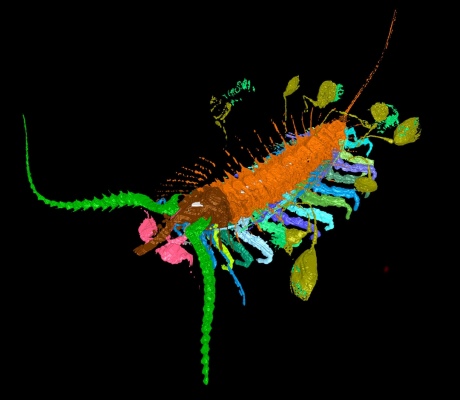Geologists have unearthed a 430-million-year-old fossilised creature that carried its young in pouches tethered to its body, like a stream of kites.
The team, who found the fossil in Herefordshire, have named it the ‘Kite Runner’, after the 2003 novel by Khalid Hosseini. In Latin, the species name for the creature is officially Aquilonifer spinosus, from ‘aquila’, which means eagle or kite, and the suffix ‘fer’, which means carry.
When I first saw the creature in its entirety my initial thought was that the ‘kites’ were parasites of some sort, although nothing like any I'd ever seen before. But the closer we looked the less likely that seemed.
– Dr Mark Sutton
The tiny fossil, measuring only about a centimetre long, is the only known example of the animal. Ten juveniles of different stages of development were found attached to it with thin, flexible threads. Its discovery is reported today in the journal Proceedings of the National Academy of Sciences.
The unusual parenting method is the only known example of its kind. The Kite Runner is a member of the arthropods, the large group of animals that includes insects, spiders and crustaceans. Many arthropods adopt different strategies to protect their young from predators, including attaching them to their limbs, holding them under their shell, or enclosing them within a special pouch until they are old enough to be released.
Co-author Dr Mark Sutton, from the Department of Earth Science & Engineering at Imperial College London, said this newly discovered strategy may have provided some benefits for the animal: “It could offer protection - the adult could have tried to fend off anything that wanted to eat the young, or carried them away from danger.
“The adult could also have moved the young to areas where they could access a better food supply. They were probably filter-feeders, extracting nutrient-particles from the water, so perhaps the adult could orient itself to any water currents to help with this.”
Growing pains
However, Dr Sutton also said there could be pitfalls to this strategy. “Arthropods grow by moulting their entire outer shell, which this animal clearly could not do while it's young were attached. We do not know how it solved this problem.” Dr Sutton suggested that perhaps the adults may have stopped moulting while they had young attached, or perhaps stopped growing and hence stopped moulting once they were old enough to reproduce.
“Modern crustaceans employ a variety of strategies to protect their eggs and embryos from predators,” said lead author Professor Derek Briggs from Yale University. “It shows that arthropods evolved a variety of brooding strategies beyond those around today - perhaps this strategy was less successful and became extinct.”
Back to life
To get a picture of what the animal looked like, the team ground away the layers of the fossil in many small increments, taking photos as they went in order to build up a 3D reconstruction.

Dr Sutton said: “When I first saw the creature in its entirety my initial thought was that the ‘kites’ were parasites of some sort, although nothing like any I'd ever seen before. But the closer we looked the less likely that seemed.
“The most telling argument for the adult wanting them to be there is that the creature has large and flexible appendages, which could certainly have removed the ‘kites’ if it wanted to. If it wanted them to be there, the only real possibility is that they were its young.”
-
'Tiny individuals attached to a new Silurian arthropod suggest a unique mode of brood care' by Derek E. G. Briggs, Derek J. Siveter, David J. Siveter, Mark D. Sutton, and David Legg is published in Proceedings of the National Academy of Sciences.
Article text (excluding photos or graphics) available under an Attribution-NonCommercial-ShareAlike Creative Commons license.
Photos and graphics subject to third party copyright used with permission or © Imperial College London.
Reporter
Hayley Dunning
Communications Division

Contact details
Tel: +44 (0)20 7594 2412
Email: h.dunning@imperial.ac.uk
Show all stories by this author




Leave a comment
Your comment may be published, displaying your name as you provide it, unless you request otherwise. Your contact details will never be published.